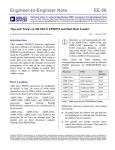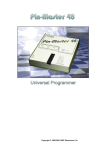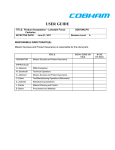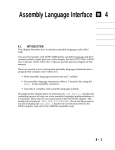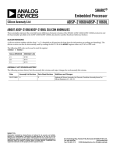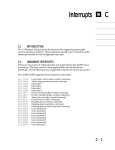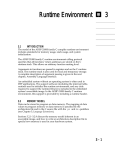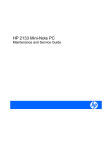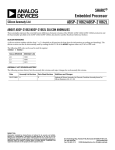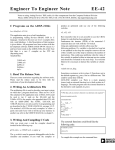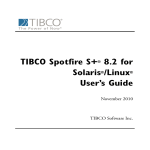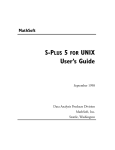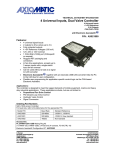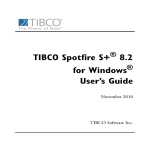Download 6 Boot Loader - Signals and Systems
Transcript
Boot
6.1
Loader
6
INTRODUCTION
The Boot Loader is a utility program supplied with the ADSP-21000
Family Development Software. The loader converts an ADSP-21xxx
executable program, generated by the linker, into a format which can
be used to boot a target hardware system and initialize its memory.
The loader’s invocation command is LDR21K.
The boot loader replaces the MEM21K memory initializer used with
the ADSP-21020 processor. Any executable file to be processed with
the LDR21K boot loader must not be processed by MEM21K. The
-nomem switch of the C compiler should be used when compiling any
C source files—this switch prevents the compiler from running
MEM21K.
The following naming conventions are used throughout this chapter:
The loader refers to LDR21K contained in the software release.
The boot loader refers to the executable file that performs the memory
initialization on the target.
The boot file refers to the output of the loader that contains the boot
loader and the formatted system configurations.
Booting refers to the process of loading the boot loader, initialization
system memory, and starting the application on the target.
Memory is referred to as being either data memory, program memory,
or internal memory. Remember that the ADSP-21020 processor has
separate external program and data memories, but does not have any
internal memory. The ADSP-2106x SHARC has both internal and
external memory.
6–1
6 Boot
Loader
To use the loader, you should be familiar with the hardware
requirements of booting an ADSP-21000 target. See Chapter 11 of the
ADSP-2106x SHARC User’s Manual or Chapter 9 of the ADSP-21020
User’s Manual for further information.
Different hardware architectures can be created with ADSP-21000
Family processors. In some systems, the ADSP-21000 processor
executes a program directly from ROM. For systems that use the
ADSP-21020 or that use the ADSP-2106x processor configured to
execute its program directly from 48-bit wide external ROM, the
PROM Splitter utility (SPL21K) is normally used instead of the loader
to create ROM-based boot files. In systems that use 8-bit wide boot
PROMs, the loader utility configures the executable code to be
downloadable through this narrower datapath. It does this by creating
a small executable, the boot loader, which is added to the assembled/
compiled source files, and is downloaded first into the processor at
reset. The boot loader then downloads the actual program to be run on
the system, initializes memory (both internal and external), and
finishes up by copying over itself and jumping to the restart vector
address. The boot loader is designed to have a minimal impact on the
target executable.
The loader supports 32-bit, 40-bit and 48-bit data memory. It is
designed for use with systems that execute from RAM, either internal,
external, or both.
The target application’s architecture file is important to the loader. It
specifies the type of processor in the target and its memory
configuration, especially the widths of the memory segments. The
loader uses this information to initialize memory correctly.
The ADSP-2106x has a special hardware feature that loads a small
program into internal memory at chip reset. This program can come
from external PROM, the host port, or the link port, based on how the
chip’s external pins are hooked up. The loader uses this feature to load
a program of arbitrary size into the ADSP-2106x’s internal and external
memory. The boot file generated by the loader can be tested in the
ADSP-2106x Simulator.
6 – 2
Boot
6.1.1
Loader 6
Types Of Boot Files
The loader can be used to create four types of loadable images: the
PROM-based loader, the host-based loader, the link port loader, and
the specialized JTAG loader.
6.1.1.1 PROM
Booting
The input to LDR21K is an executable file. From that file, the loader
generates a PROM-based loader file (*.ldr ) that can be programmed
into a PROM chip. This file can be used as an input to most PROM/
EPROM/EEPROM programmers.
Based on the requirements of your system design, you may need to
change the 060_prom.asm file. If so, here is how to recompile it (be
sure to copy the original 060_prom.asm file to your local directory,
and only edit this copy of the original file):
asm21k -adsp21060 060_prom
ld21k -a 060_ldr.ach 060_prom
6.1.1.2 Host
Booting
Command line switches -bhost and -f are used to generate a
host-based loader: From the input file (*.exe ), the loader generates a
loader file (*.ldr) that can be used as an input or data file for a host
based program that boots the processor through the data and address
buses of the external port.
Based on the requirements of your system design, you may need to
change the 060_host.asm file. If so, here is how to recompile it (be
sure to copy the original 060_host.asm file to your local directory,
and only edit this copy of the original file):
asm21k -adsp21060 060_host
ld21k -a 060_ldr.ach 060_host
6 – 3
6 Boot
6.1.1.3
Loader
Link Port Booting
The LDR21K loader option -blink is used to generate an .ldr file
that facilitates booting from an external source (such as a host
processor) through the ADSP-2106x’s link port buffer 4 using DMA
channel 6. This .ldr file is loaded as a variable within the host’s
program and transmitted over the link port to load the booting
processor. An example is included later in this chapter that illustrates
the details of this process.
Based on the requirements of your system design, you may need to
change the 060_link.asm file. If so, here is how to recompile it (be
sure to copy the original 060_link.asm file to your local directory,
and only edit this copy of the original file):
asm21k -adsp21060 060_link
ld21k -a 060_ldr.ach 060_link
6.1.1.4
JTAG Booting (ADSP-21020)
The LDR21K loader may be used to download a small kernel of
booting instructions that utilize the JTAG test access port (TAP) of the
ADSP-21020 processor. The command line switch -bjtag is used to
generate a boot file for the JTAG port. For complete information on
JTAG booting of the ADSP-21020, see Chapter 10, JTAG Downloader, in
the ADSP-21000 Family Applications Handbook, Volume 1. Sample source
code and hardware design information are included.
Based on the requirements of your system design, you may need to
change the 020_jtag.asm file. If so, here is how to recompile it (be
sure to copy the original 020_jtag.asm file to your local directory,
and only edit this copy of the original file):
asm21k
020_jtag
ld21k -a 020_jtag.ach 020_jtag
6.1.2
Distribution
Files
For proper operation, the loader requires that the following files are
located in the distribution directory of your disk.
In the ADI_DSP/21k/bin/ directory:
LDR21K
6 – 4
Boot
Loader 6
In the ADI_DSP/21k/etc/ directory:
060_ldr.ach
060_host.asm
060_host.exe
060_prom.asm
060_prom.exe
060_link.asm
060_link.exe
jtagboot.asm
jtagboot.ach
jtagboot.exe
020_jtag.asm
020_jtag.ach
020_jtag.exe
Note: The 060_ldr.ach file is a generic architecture file for PROM,
host, or link port booting of all SHARC processors.
6.2
LOADER
INVOKING THE
The loader is invoked with the LDR21K command. Any file that has been
successfully processed by the linker can be used as input to the loader.
Several options are available through the use of command line switches
and additional files. The command line command structure is:
LDR21K infile
[-a filename -b {type}
-c {custom}
-e {segment} -f {format) -h
-l filename -o filename -v -t N ]
Implementation Notes:
• Any executable (a C source program, assembly program, etc.) can be
processed by the loader. The only requirement for an ADSP-2106x
program to be processed is that it must not use address 0x020004 to
store an instruction. The loader requires this location for last minute
patching of the system state before starting the target executable. Your
program should have a NOP or IDLE instruction at address 0x020004.
• The target application should be aware the DMAC6 control register on
the ADSP-2106x will not equal zero. This is noted in the SHARC User’s
Manual.
6 – 5
6 Boot
Loader
• The loader takes the place of the MEM21K application. If you use the
loader to initialize your target’s memory, it is not necessary to use the
MEM21K application. If you are using the C compiler, G21K , you
should use the -nomem switch on the compilation line to stop the
compiler from processing your executable with MEM21K .
• The input to LDR21K is an executable file generated by the Linker.
Some of the boot loaders require particular segments to be defined.
These requirements can be found in the section that discusses the
types of loaders.
6.2.1
Command
Line
Switches
The loader supports the following command line switches:
• -a [architecture filename ]
Specify an alternate architecture file. LDR21K follows the normal
convention for default architecture file specification.
• -b[type]
Where type indicates the method of booting to be used. The value of
type can be prom, host, link, or JTAG. The default is -bprom .
• -c[custom option ]
This switch causes the loader to change operation for a custom boot
loader file. See the discussion on customizing your loader before using
this option. Multiple -c switches may be used on the command line.
The available options for custom option are 20004 and 20040.
• -e[segment name ]
Where segment name describes a segment in the architecture file that
should be considered to contain 40-bit extended precision data. This
switch will override a \WIDTH directive in the architecture
description file.
• -f[format]
Where format describes the output format of the .ldr file. The value
of format can be hex for Intel hex records, ASCII for a 16-bit ASCII file,
include for a file suitable to include as initialization data for a C
program, or binary for a binary output file. The default is -fhex .
The binary file format requires less space on a hard disk, and can be
faster to read than the include or ascii formats. The binary format stores
6 – 6
Boot
Loader 6
48-bit words in three 16-bit blocks. The 16-bit blocks are written in the
same order as all of the other formats. A typical code sequence used to
access the binary file would be:
fd = fopen ("filename.ldr", READ_BINARY);
while (!feof (fd))
{
fread (&short_data, 2, 1, fd);
send_16bit_word_to_ADSP2106x (short_data);
}
• -h
Help. Displays the command line syntax and a brief list of options.
• -l [boot loader filename]
Specifies an alternate boot loader for this boot file. If this option is not
specified, the loader will use the boot loader in the current directory (if
available), or from the ADI_DSP/21k/etc subdirectory. See the
discussion on customizing the boot loader before using this option.
• -o [output filename]
Specifies an alternate output file. LDR21K uses the base of the input
filename with the extension .ldr by default.
• -v
Displays verbose output while running.
• -t [N]
Specifies the maximum bus lock time. See the discussion below under
“–t Switch”.
6.2.2
-t Switch
There is a switch option of the loader which limits the number of cycles
that the SHARC will spend on initializations. The switch is -t followed
by a number (N). The number N is linearly related to the number of cycles
that the SHARC will lock the bus during booting. Specifically, the number
N instructs the SHARC to lock the bus for about 2*N cycles at most. So, if
you have a very fast host that does not like to be locked out, use a
relatively small value for N; for example, -t5. N must be a positive, nonzero integer value greater than or equal to 4:
N≥4
6 – 7
6 Boot
Loader
Ideally, the value of N should be calculated from the amount of time
the host (or bus) can tolerate a timeout. If the host can only tolerate
10 µsec of bus lock, N would be:
10 µsec
1
SS
N = .75
2
(( ) )
where SS is the speed of the processor in MHz and 1/SS is the
processor cycle time. The .75 multiplier represents a 75% scaling factor.
6.2.3
Examples
PROM-Based Loader
The input to LDR21K is an executable file. Once you have created an
executable file, the following command generates a PROM-based
loader file (in the Intel Hex-32 file format):
LDR21K filename.exe
A loader file (filename.ldr) generated with this command line can
be used as an input to most PROM programmers.
Host-Based Loader
Use the following command line to generate a host-based loader:
LDR21K filename.exe -bhost -fascii
The loader file (filename.ldr) can be used as an input or data file
for a host based program.
Link Port Loader
To create a link port boot file for your system, invoke the loader with
its –blink switch:
LDR21K filename.exe –blink -fascii
This output file (filename.ldr) can be used as a data file for the
booting device connected to link buffer 4.
6 – 8
Boot
Loader 6
JTAG Loader
To create a JTAG boot file for your ADSP-21020 system, invoke the loader
with its –bJTAG switch:
LDR21K filename.exe –bJTAG
This output file (filename.ldr) can be used as a data file for the booting
device connected to the JTAG-compliant test access port (TAP).
6.3
LOADER
FILES
SIMULATING
The wsim060 and wsim020 simulators support the simulation of boot
loading for both the host and PROM formats.
To simulate a loader file, it is necessary to modify one or more entries in
the wsim060.ini (for the ADSP-2106x simulator) or wsim020.ini
(for the ADSP-21020 simulator) files. Use a text editor to open the
appropriate *.ini file and make the necessary modifications. In the
startup section [startup_sect] , locate the following entry:
; "ldr_file=dev:\path\file" designates a loader file to boot upon
; startup.
; A "loader" file (*.ldr) is generated by the LDR21K.exe program
; and used for simulation of the DMA boot process.
; Specifying both an exe_file and a ldr_file generates an error.
;ldr_file=
Remove the ‘;’ in front of the last line of this entry and add the name of the
*.ldr file to the right of the ‘=‘ operator. Do not allow spaces between
characters. Specify the full drive and pathway. For example:
6 – 9
6 Boot
Loader
ldr_file=c:\adi_dsp\21k\proj\exp.ldr
If an ldr_file and an exe_file are both specified in the *.ini
file, an error message will be generated when the simulator is started up.
The exe_file assignment statement must be removed from the *.ini
file by adding a ‘;’ as the first character in that line. This “comments out”
the statement so that it is seen by the simulator program as a simple
comment line, and thus ignored. To do this, locate the following entry:
;
;
;
;
;
;
"exe_file=dev:\path\file" designates an executable file to load
upon startup.
Default is "21k.exe" in the "Working Directory" as specified for the
wsim21k.exe program item by the File/Properties menu of
the Windows Program Manager.
Specifying both an exe_file and a ldr_file generates an error.
exe_file= c:\adi_dsp\21k\proj\cache.exe
Change the last line to:
;exe_fle= c:\adi_dsp\21k\proj\cache.exe
Then save the file and exit the text editor. When the simulator is started
up, the specified *.ldr file is loaded into the simulator. The simulator
determines which type of boot to simulate, and when the Execute|Run/
Halt menu function (or the F4 hotkey) is selected it immediately begins
the boot process. You can interrupt the boot process by pressing the F4
hotkey. Booting can be resumed by reselecting the Execute|Run/Halt
menu function (or the F4 hotkey).
6.4
BOOT FILE
CREATING A
An ADSP-2106x executable program to be used with the loader must not
have an instruction located at address 0x020004 in internal memory—the
loader uses this location for last-minute patching of the system state
before jumping to the restart vector. A NOP or IDLE instruction should
be placed at this location. Remember also that DMA Channel 6 is used for
EPROM, host, and link port booting, and the DMAC6 control register is
specially initialized for this purpose.
LDR21K uses a five-step process to create a boot file:
6 – 10
Boot
1.
2.
3.
4.
5.
Loader 6
Parse the executable file.
Separate zero-valued initializations.
Write the specified boot loader to the boot file.
Write the memory initialization blocks to the boot file.
Write the final initialization (that overwrites the boot loader).
The following paragraphs describe each of these steps in detail. The
boot file is always generated with the least significant values first.
6.4.1
ParsingThe Executable File
The loader reads the executable file to determine which segments are
RAM based, and therefor need to be copied into the boot file. All
segments that are declared as RAM in the architecture description file
and contain initialization data are processed by the loader. The loader
ignores segments that are declared in the architecture description file
as ROM, and any segment that does not contain data.
The loader supports executables that have both RAM and ROM
segments. The ROM segments are processed using the PROM splitter
(spl21k ) tool, while the RAM based segments are processed by the
loader.
6.4.2
Separating
Zero-Valued
Initializations
Executables often contain large ranges of memory that are initialized to
zero at system startup. These ranges can be efficiently represented as a
single 48-bit word, rather than storing a long string of zeros, and can
be performed more efficiently at boot time.
The RAM sections are scanned for runs of zero-valued initializations.
These areas are then removed from the surrounding non-zero
initializations and compressed.
6.4.3
Writing The Boot Loader
The boot loader contains instructions to read the rest of the boot file
and initialize the system RAM. This means that the boot loader must
be the first part of the boot file downloaded to the target. Therefore,
the loader copies the boot loader to the beginning of the boot file.
The ADSP-2106x automatically boots 256 48-bit words from the
appropriate device in all of its booting modes. The ADSP-21020
processor with JTAG boot support also reads 256 48-bit words from
the boot PROM into the interrupt vector table. In most cases, the boot
6 – 11
6 Boot
Loader
loader is the default version supplied with the tools release in the
ADI_DSP/21k/etc directory as executable files.
If there are particular hardware requirements or features in your
application that need to be initialized before system memory, the boot
loader can be customized for your requirements. See the sections later
in this chapter discussing the appropriate boot loader for more details.
6.4.4
Writing Memory Initialization Blocks
The initialization data is written into the boot file following the boot
loader. This is because the boot loader is responsible for initializing
memory based on the specific boot format that the loader produces.
The boot loaders for the ADSP-2106x initialize external memory by
reading a word into internal memory, then writing that word to
external memory.
When the boot loader attempts to access external memory, the boot
loader sets the buslock bit (BUSLK bit of the MODE2 register) to lock
the host off of the external bus. After the initialization values (or zero
values) have been written to memory, the buslock bit is deasserted,
allowing the host to write additional data to the processor.
Note: The period of time that the processor locks the bus can be
limited using the -t switch.
Each initialization block is identified by a 48-bit tag which preceeds the
block. Each type of initialization (e.g. zero 32 bit, initialize 40 bit ...) has
a unique tag number. The tags for each type of initialization are listed
in Table 6.1:
6 – 12
Tag Number
0
1
2
3
4
5
6
7
8
9
10
11
12
13
14
Table 6.1
Initialization Type
FINAL INIT
ZERO DM16
ZERO DM32
ZERO DM40
INIT DM16
INIT DM32
INIT DM40
ZERO PM16
ZERO PM32
ZERO PM40
ZERO PM48
INIT PM16
INIT PM32
INIT PM40
INIT PM48
Memory Initialization Block Tag Numbers
Boot
6.4.4.1 Zero-Valued
Initialization
Loader 6
Format
When the boot loader reads a tag whose value is 1, 2 ,3 7, 8, 9, or 10, it
executes the appropriate initialization routine. A single 48-bit word
following the tag is an address length pair indicating the starting
address of the memory block in the upper 32-bits and the length of the
initialization in the lower 16-bits.
An initialization of 16 or 32 bit memory (either PM, DM, Internal, or
External) is done in a loop which writes a zero-value DREG to
memory. Any initialization of 40 or 48-bit PM memory uses a write
with the PX register set to zero. After the boot loader completes this
initialization block, it reads the next tag and executes the appropriate
initialization routine.
The loader will break a large initialization into two (or more) smaller
initialization sequences if necessary. The loader does this when the
length of the segment exceeds either 65535 (16-bit) words, or if it
exceeds the value specified with the -t command line option.
6.4.4.2 Non-Zero
Initialization
Format
When the boot loader reads a tag whose value is 4, 5, 6, 11, 12, 13, or
14, it executes the appropriate routine to initialize memory to a nonzero value. A single 48-bit word following the tag is an address length
pair indicating the starting address of the memory block in the upper
32-bits and the length of the initialization in the lower 16-bits.
The boot loader enters a loop which reads one 48-bit word and writes
the appropriate width value to memory. This loop is repeated once for
each word being initialized. After the boot loader reads each value
from the host, link, or PROM, it locks the bus while it writes the value
to memory. The bus is unlocked when the write is completed.
When the boot loader has finished initializing the specified memory
block, it reads the next tag and executes the appropriate initialization
routine.
The loader will break a large initialization into two (or more) smaller
initialization sequences if necessary. The loader does this when the
length of the segment exceeds either 65535 (16-bit) words, or if it
exceeds the value specified with the -t command line option.
6 – 13
6 Boot
6.4.5
Loader
Writing The Final Initialization
The final initialization is indicated by a 0 value tag. When the loader
detects this tag, it reads the next 48-bit word. This word indicates the
instruction that should be located at 0x20040 when the loading is
complete.
The next 256 48-bit words are loaded into memory over the boot loader.
This process is executed with a DMA transfer sequence of 256 words
which, when completed, RTI is executed at address 0x20040, returning
to address 0x20004. An instruction at this address sets SYSCON to its
initialization value, and writes the correct instruction at address 0x20040.
The code then proceeds to address 0x20005 which should be the
beginning of user application code.
Note that only the DMAC6 register has a different value than at the
startup condition. The user application code is otherwise intact.
6.5
SPECIALIZED
BOOT FILES
6.5.1 PROM Boot File For SHARC Clusters
The LDR21K loader allows clusters of SHARCs to be booted from a
single PROM. For ADSP-2106x silicon earlier than revision 1.0, the BMS
signals of all SHARCs must be ANDed together and tied to the boot
PROM’s chip select. For revision 1.0 silicon and later, all the SHARC’s
BMS signals may be tied directly together and to the PROM’s chip select.
The loader accepts multiple executables in its command line. The first
.exe in the loader command line will be loaded into the processor with
ID=1, the second .exe will be loaded into the processor with ID=2, etc.,
up to six processors.
6.6
EXAMPLES
6.6.1 EPROM Boot File
DETAILED
Creating an EPROM boot file for your system is the simplest type of boot
file to make. Run the loader on your executable file with its –bprom
switch:
LDR21K filename.exe –bprom
6 – 14
Boot
Loader 6
The output file, filename.ldr , can be used with a PROM programming
device to create the boot EPROMs or EEPROMs for your system.
It may seem as if the Prom Splitter tool and the Loader tool are used for
the same purpose. Actually, each tool has its own area of applications. In
general, the PROM Splitter is used to create EPROMs in cases where 48-bit
wide program memory (or even 32-bit wide data memory) external
PROMs are used. All members of the ADSP-21000 Family could use the
PROM Splitter in these circumstances.
On the other hand, the Loader is capable of creating boot code of any
standard bit-width from byte-wide (8-bit) external EPROMs. Because of
this, and the ADSP-2106x SHARC’s more flexible booting options, the
loader is the preferred tool.
6.6.2
Host Processor Boot File
To create a host processor boot file for your ADSP-2106x SHARC-based
system, invoke the loader with its –bhost and –fascii command
line switches:
LDR21K filename.exe
–bhost –fascii
This output file, filename.ldr , can be used as an input or data file for
the host processor’s program to transmit to the SHARC processor at the
proper time. The –fascii switch formats the output as a 16-bit ASCII
file, since the 16-bit bus width will be used at the ADSP-2106x’s external
port.
When host booting is configured, the ADSP-2106x will enter slave mode
after reset, waiting for the host processor to download the boot code. The
host boot file created by the loader (filename.ldr ) requires the host
processor to perform the following sequence of actions:
1. The host initiates the booting operation by asserting the ADSP-2106x’s
HBR input.
2. After the host receives the HBG signal back from the ADSP-2106x, it
should write three 16-bit words to the external port DMA buffer 0 (EPB0).
(EPB0 corresponds to DMA channel 6.)
6 – 15
6 Boot
Loader
3. The host can continue to write 16-bit words to EPB0 until the entire
program is booted.
This simple procedure can be used as long as the entire application
will reside only in the ADSP-2106x’s internal memory. If any portions
of the application are planned to reside in external memory, however,
the host processor must deassert HBR after writing each 48-bit
instruction (in three 16-bit words). This allows the boot loader
program (running on the ADSP-2106x) to gain control of the bus, lock
it, and transfer the data to external memory. The boot loader will
complete any necessary transfers and then unlock the bus, letting the
host regain control. This protocol allows boot loading to occur with
very little software or support on the part of the host.
To summarize this procedure, when some (or all) of the application
program is to be stored in external RAM, the host should follow these
steps:
1. The host asserts HBR.
2. After receiving HBG back, the host writes three 16-bit words to the
EPB0 buffer.
3. The host deasserts HBR.
4. Continue back to Step 1 if more instructions are to be booted.
6.6.3
Link Port Booting
To create a link port boot file for your system, invoke the loader with
its –blink switch:
LDR21K filename.exe
–blink
This output file, filename.ldr , can be used as a data file for the
booting device connected to link buffer 4.
Example link boot files are located in the 21k/etc/linkboot
subdirectory. This example is designed to run on the ADSP-2106x
EZ-LAB board, but may be modified for any system architecture. For
the purpose of the example, assume a system design that has a
primary SHARC processor link booting a secondary SHARC
processor. The primary processor transmits the boot code from its link
ports to the link ports of the secondary processor.
6 – 16
1. Create the example file to be run on the secondary processor. In this
case this file will be lsrq.asm , which uses a timer to cause an
LSRQ interrupt on the primary processor and blinks an LED
Boot
Loader 6
attached to flag0 (on the EZ-LAB board) every time the interrupt
is received. Use make1.bat to produce the lsrq.ldr file.
2. Create the example program to run on the primary processor (the
transmitting link port). You must incorporate a routine here
(blsrq.asm) to transmit the secondary processor’s program over
the link. This transmitter routine is called before the primary
processor begins to run its main program.
The LOADLENGTH variable in the blsrq.asm file must be
changed each time the size of the transmitted file changes. Read the
comments within the program blsrq.asm for more details. The
blsrq.asm example will blink the EZ-LAB’s LED attached to
FLAG0 every time the interrupt is received. Use make2.bat to
produce the .exe or .ldr file for prom booting of blsrq.asm into
the primary processor.
6.7
PROCESS
THE BOOT
The actual boot process is similar for all four boot modes, but each is
slightly different.
The simplest form of booting uses a Boot EPROM connected to the
external address/data ports of the processor. The Boot EPROM
program is mapped so that the first instruction is located at a specific
address for that processor; see the appropriate processor reference
manual for details. Execution of the application program then
proceeds normally.
The other three boot modes will typically require the use of the loader
utility to accommodate the physical means of downloading the boot
loader executable into the target processor. In general, the boot process
begins by downloading the boot loader onto the target system. The
boot loader then sets up the system as necessary, and begins to load
initialization data. The boot loader initializes the entire system, with
the exception of the area occupied by the loader itself. Once the boot
loader has finished initializing the rest of the system, it needs to load
over itself. This is the most difficult operation, and is unique to each
boot mode.
6 – 17
6 Boot
6.7.1
Loader
The ADSP-2106x PROM Loader
The PROM loader is used when the external boot PROM is connected to
the ADSP-2106x. PROM booting is activated by setting the EBOOT pin
to high and the LBOOT pin low. The BMS pin is the chip select line for
the boot PROM in this mode.
DMA channel 6 is set up at reset with the following values:
II
IM
C
CP
GP
EI
DMAC6
0x20000
uninitialized
0x100
uninitialized
uninitialized
uninitialized
0x02A1
The DMA is set up for external port DMA enable, DTYPE is selected
for instructions and packing mode is forced to 8-to-48 bit packing. The
packing order is LSW first. The IMASK register is set to allow DMA6
interrupts.
The IM and EM registers are uninitialized, but the boot hardware
works as if IM is set to 0x100 and EM is set to 0x600.
The byte-wide boot PROM must be connected to data bus pins
DATA(23:16). The lowest address pins of the ADSP-2106x should be
connected to the PROM address bits. The PROM’s chip select should be
connected to BMS and its output enable should be connected to RD.
The WAIT register is initialized to generate 6 wait states for each
PROM access.
This loader uses an external PROM to hold the program. The first 256
48-bit words in the PROM are loaded automatically by the ADSP-2106x.
This code represents the boot loader executable.
The boot loader accesses the boot file in the PROM by toggling the BSO
bit in the SYSCON register. When the BSO bit is active, only the boot
PROM can be accessed as external memory. When the BSO bit is
deactivated, the ADSP-2106x can only access external memory.
The internal memory is initialized, followed by the loader overwriting
itself.
6 – 18
The DMA automatically uses an 8-to-48 bit packing mode when the BSO
Boot
Loader 6
bit is enabled. The BSO bit deselects the external memory and
accesses the boot PROM.
The last step of the boot loader is to initialize the memory in which it
resides.
6.7.2
The ADSP-2106x Host Loader
This loader assumes that there is an external host that will be sending
information to the ADSP-2106x through the external port EP0. The
DMA is placed in slave mode, so the host is responsible for
transferring data to the ADSP-2106x.
When hardware reset occurs, the ADSP-2106x core enters the IDLE
state at location 0x20004, and the DMA corresponding to channel 6 is
initialized with the following values:
DMAC6
II6
C6
0x00A1
0x020000
0x0100
The host must assert the host bus request pin to indicate that it wants
to send data to the ADSP-2106x. After the host receives the host bus
grant signal from the ADSP-2106x, it should write three 16-bit words
to DMA buffer 0 (DMAB0 corresponds to DMA channel 6).
If any portion of the appliction program resides in external memory,
the host should drop the host bus request signal after writing three
words. The host must drop the host bus request signal for at least five
ADSP-2106x instruction cycles. The host may assert the host bus
request signal any time after five instruction cycles.
When the host drops the host bus request signal, the ADSP-2106x has
the option of locking the bus. Once the bus is locked, the ADSP-2106x
can transfer data to external memory. The ADSP-2106x completes any
necessary transfers, and unlocks the bus.
This protocol allows booting to occur with very little software or
support of the host.
The host must supply data on the DATA(31:16) pins, and the write
address must be for DMAB0 .
The DMA control register of the ADSP-2106x is set for DMA enabled,
DTYPE selected for instructions, and packing mode set for 16-to-48
bits with LSW first.
6 – 19
6 Boot
Loader
When the host boot is complete, the ADSP-2106x application is started.
The application must be aware that the value in DMAC6 is non-zero, and
that the IMASK is set to allow DMA6 interrupts.
6.8
EXECUTABLES
LOADER
There are four different boot loader executables, one for each type of
loader file generated by LDR21K . This section describes how each loader
works, and how to customize the loaders for your application.
The sources for the boot loader executables are located in the library
source directory. The library source directory is ADI_DSP/21k/lib/src
. You should copy the source file to a working directory and only modify
the working copy. Do not modify the source file.
There is an architecture file associated with the loader. The architecture
file is necessary because each loader must be an executable file, rather than
just an object file. The architecture file indicates what memory is used by
the loader, and what memory is used for temporary storage.
The boot loader is a small assembly language program that initializes
system memory, based the initialization data. The boot loaders are all 256
words long.
The following paragraphs describe the boot loaders in detail. You should
refer to these paragraphs if you need to modify the loader for your
application.
6.8.1
Prom
Loader
060_prom.asm is the assembly source file for the ADSP-2106x PROM
loader. The architecture file is named 060_ldr.ach.
060_prom.asm contains the boot loader that is loaded into seg_ldr at
reset. The file begins by defining macros that contain addresses of various
IOP registers that are used in the code.
The boot loader itself begins with part of the interrupt vector table of the
ADSP-2106x. The table contains the interrupts vectors, up to and including
6 – 20
Boot
Loader 6
the low priority timer interrupt. Most of these interrupts are not
necessary for the operation of the boot loader, but were included in
case custom modifications required them.
The only interrupts used by the boot loader are the reset interrupt
(0x020004 - 0x020007) and the DMA6 interrupt (0x020040 - 0x020043).
The boot loader begins by reading the current value of the SYSCON
register and saving it. Three copies of SYSCON are used in the
program; one that contains the original value of SYSCON , one that
contains SYSCON with the BSO bit set, and a third with the BSO bit
cleared.
The IMASK register is set to allow DMA6 and DMA7 interrupts, and
the MODE1 register is set to enable interrupts and allow nesting.
The boot loader uses a routine called read_PROM_word to fetch a
single 48-bit word from the PROM. The boot loader reads a tag from
the PROM to determine what type of initialization should be
performed. The boot loader executes a small routine to initialize the
memory as defined by the tag.
After a block of memory has been initialized, the boot loader jumps
back and and reads the next tag from the PROM. When a tag of 0 is
read, the loader executed the final initialization.
Final Initialization
The boot loader reads a word from the boot PROM. This 48-bit word
represents the instruction that belongs at address 0x20040 for the target
application. This instruction is loaded into the 48-bit PX register after
the boot loader has finished initializing internal memory. The boot
loader requires that address 0x020040 (the DMA6 vector address)
contain an RTI instruction because a DMA6 interrupt is generated
when the initialization is complete.
6 – 21
6 Boot
Loader
The R9 register is loaded with 0xb1db0000; this is the encoded
instruction PM(0,I8)=PX .
The boot loader then reads in the next 256 words from the boot PROM.
This data overwrites the loader itself.
6.8.2
Host Loader
060_host.asm is the source file for the ADSP-2106x Host loader.
060_host.asm contains the boot loader that is loaded into seg_ldr
at reset. The file begins by defining macros that contain addresses of
various IOP registers that are used in the code.
The boot loader itself begins with part of the interrupt vector table of
the ADSP-2106x. The table contains the interrupts vectors, up to and
including the low priority timer interrupt. Most of these interrupts are
not necessary for the operation of the boot loader, but were included in
case custom modifications required them.
The only interrupts used by the boot loader are the reset interrupt
(0x020004 - 0x020007) and the DMA6 interrupt (0x020040 - 0x020043).
The boot loader begins by reading the current value of the SYSCON
register and saving it. Three copies of SYSCON are used in the
program; one that contains the original value of SYSCON , one that
contains SYSCON with the BSO bit set, and a third with the BSO bit
cleared.
The IMASK register is set to allow DMA6 interrupts, and the MODE1
register is set to enable interrupts and allow nesting.
The boot loader uses a routine called read_PROM_word to fetch a
single 48-bit word from the host. The DMA6 interrupt vector sets the
bus lock bit of the mode register, preventing host bus access. The boot
loader reads a tag from the 48-bit word retrieved from the host to
determine what type of initialization should be performed. The boot
loader executes a small routine to initialize the memory as defined by
6 – 22
Boot
Loader 6
the tag. The bus lock is cleared and the boot loader if free to attemp
reading another word from the host.
After a block of memory has been initialized, the boot loader jumps
back and and reads the next tag from the host. When a tag of 0 is read,
the loader executed the final initialization.
Final Initialization
The boot loader reads a word from the host. This 48-bit word
represents the instruction that belongs at address 0x20040 for the target
application. This instruction is loaded into the 48-bit PX register after
the boot loader has finished initializing internal memory. The boot
loader requires that address 0x020040 (the DMA6 vector address)
contain an RTI instruction because a DMA6 interrupt is generated
when the initialization is complete.
The R9 register is loaded with 0xb1db0000; this is the encoded
instruction PM(0,I8)=PX . The contents of R9 are stored at address
0x20040. This instruction is executed and overwrites the proper
instruction into location 0x20040.
6.8.3
Link
Loader
060_link.asm is the source file for the ADSP-2106x Link loader.
6.8.4
JTAG Loader (ADSP-21020)
020_jtag.asm is the source file for the ADSP-21020 JTAG loader.
The architecture file looks like the following:
.SYSTEM ADSP21020_JTAG_boot_strap_loader_Architecture;
.PROCESSOR = ADSP21020;
.SEGMENT/PM/RAM/BEGIN=0x00001000 /END=0x000001ff
seg_ldr;
.SEGMENT/DM/ROM/BEGIN=0x00800000 /END=0x00ffffff
boot_rom;
.ENDSYS;
020_jtag.asm contains the boot loader that is loaded into seg_ldr
at reset. This segment is initialized by the jtagboot routine and is
loaded over the JTAG TAP. The boot loader then reads the external
PROM. Each time it reads from memory, it reads six 48-bit words. The
control structure is similar to the 060_prom.asm file described
earlier.
The boot loader uses a routine called read_PROM_word to fetch a
single 48-bit word from the boot PROM. The boot loader reads a tag
from the 48-bit word retrieved from the boot PROM to determine what
type of initialization should be performed. The boot loader executes a
6 – 23
6 Boot
Loader
small routine to initialize the memory as defined by the tag.
After a block of memory has been initialized, the boot loader jumps
back and and reads the next tag from the host. When a tag of 0 is read,
the loader executed the final initialization.
6.9
MESSAGES
ERROR
LDR21K may generate the following runtime error messages:
ADI_DSP environment variable not defined
This message indicates that the environment variable ADI_DSP is not
defined. This variable should point to the base of the distribution
directory for the software tools. See the installation instructions.
Illegal flag ".." ignored
LDR21K encountered a switch that it did not expect. As the message
indicates, the switch is ignored and processing continues.
Address 0x20004 should be a NOP or IDLE
The loader uses address 0x020004 to store an instruction which resets
the processor to it’s reset state after boot loading is complete. User
code should not use address 0x20004 to store a valid instruction.
The loader replaces the instruction currently at address 0x020004 with
the necessary instruction. If you application uses address 0x020004,
you must customize the boot loader.
See the section on the host or PROM loader for more information on
the use address 0x020004 by the loader.
Unknown loader section ".." encountered
6 – 24
This error indicates that an unknown section is included in the boot
loader executable. The only segments that have any meaning in the
boot loader executable are seg_tmp and seg_ldr , all other
segments are ignored.
Boot
Loader 6
If you use a custom loader, be aware that all segments other than seg_tmp
and seg_ldr are ignored.
If you are using one of the boot loader executables provided in the software
releases, this probably indicates an installation error.
-a switch used without a file name
This message indicates that an attempt was made to use the -a switch
without a corresponding architecture file name. See the section on command
line switches for more information.
-o switch used without a file name
This message indicates that an attempt was made to use the -o switch
without a corresponding output file name. See the section on command line
switches for more information.
Unable to parse ".."
This error occurs if the loader is unable to parse the architecture file. This error
message is preceded by another message indicating the specific problem
encountered.
Unable to read file header
the loader is not the proper (COFF) file format. This error can occur when
attempting to read the input executable to the loader, or when attempting to
read the boot loader executable.
If this error occurs, make sure that you are using the correct file for input.
Unable to read optional header
6 – 25
6 Boot
Loader
This error occurs if one of the input files to the loader is not the proper
(COFF) file format. This error can occur when attempting to read the input
executable to the loader, or when attempting to read the boot loader
executable.
If this error occurs, make sure that you are using the correct file for input.
Unable to read section header
This error occurs if one of the input files to the loader is not the proper
(COFF) file format. This error can occur when attempting to read the input
executable to the loader, or when attempting to read the boot loader
executable.
If this error occurs, make sure that you are using the correct file for input.
Unable to open boot loader file ".."
This error indicates that the loader was not able to open the specified boot
loader executable. It may indicate an installation error, or that the boot
loader executable specified on the command line is incorrect.
Improper start address for loader
This error indicates that there is a problem in the format of the boot loader
executable. The hardware boot sequence on the ADSP-2106x loads in 256
48-bit words starting at address 0x020000. The boot loader executable must
begin at address 0x020000. These addresses can be filled with NOPs , but
they must be filled.
If you are using a custom boot loader executable, you should edit, reassemble, and re-link your boot loader. If you are using the standard loader
provided with your software release, this error probably indicates an
installation error.
Improper length for loader
6 – 26
This error indicates that the boot loader executable is longer than 256 48-bit
words. The hardware boot sequence on the ADSP-2106x loads in 256 48-bit
words starting at address 0x020000. The boot loader executable must be less
than or equal to 256 48-bit words in length or unexpected result may occur.
If you are using a custom boot loader executable, you should edit, reassemble, and re-link your boot loader. If you are using the standard loader


























